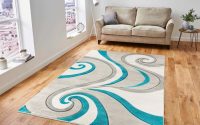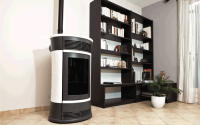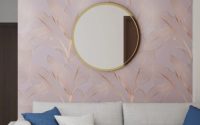Deko Wohnzimmer Wand Ideen & Gestaltung
Wandgestaltung im Wohnzimmer
Deko wohnzimmer wand – Right then, chaps! Let’s get cracking on jazzing up those living room walls. We’ve already sorted the intro and outro, so let’s dive straight into the nitty-gritty of wall design trends and styles. Think of this as your ultimate cheat sheet for achieving the perfect vibe in your crib.
Aktuelle Trends bei der Wohnzimmerwandgestaltung
So, what’s hot right now in the world of wall decor? Well, mate, it’s all about creating a personal sanctuary that reflects your unique style. We’re seeing a move away from stark minimalism towards a more layered and textured approach. Think bold colours, statement wallpapers, and the strategic use of natural materials to bring the outside in.
The key is to find a balance between stylish and comfortable. It’s all about creating a space that feels both sophisticated and utterly relaxing. Think cosy nights in, not sterile showrooms.
Vergleich verschiedener Wohnstile und ihrer typischen Wandgestaltungen
Alright, let’s compare and contrast some popular styles. Modern styles often lean towards clean lines and neutral palettes, with a focus on texture through materials like exposed brick or sleek plaster. Classic styles, on the other hand, favour more ornate details, richer colours, and perhaps some panelling for a touch of old-school charm. Think stately homes, but with a modern twist.
Then we’ve got the countryside vibe, the Landhaus style, which screams rustic charm with its warm tones, natural materials like wood and stone, and often features floral patterns or subtle textures. Each style brings its own unique character, and it’s up to you to find the one that resonates most with your personal aesthetic.
Stil, Farben, Materialien und Dekoration im Überblick
Here’s a table to summarise the key features of each style, providing a handy reference point for your design journey.
| Stil | Farben | Materialien | Beispiele für Dekoration |
|---|---|---|---|
| Modern | Neutral (Grau, Weiß, Beige), Akzente in kräftigen Farben | Putz, Beton, Glas, Metall | Minimalistische Bilder, geometrische Muster, moderne Skulpturen |
| Klassisch | Dunkle, erdige Töne (Blau, Grün, Rot), Goldakzente | Tapeten mit Mustern, Holzvertäfelung, Stuck | Spiegel in antikem Stil, Ölgemälde, Kerzenleuchter |
| Landhaus | Warme, natürliche Töne (Beige, Braun, Grün), Pastelltöne | Holz, Stein, Leinen, Baumwolle | Blumenmuster, Holzrahmen, Wandregale mit Deko-Objekten |
| Boho | Erdtöne, kräftige Farben (Türkis, Orange, Rot), viele Muster | Textilien (Teppiche, Kissen), Makramee, Holz | Ethnische Muster, Pflanzen, Wandteppiche |
Farben und Materialien für die Wohnzimmerwand
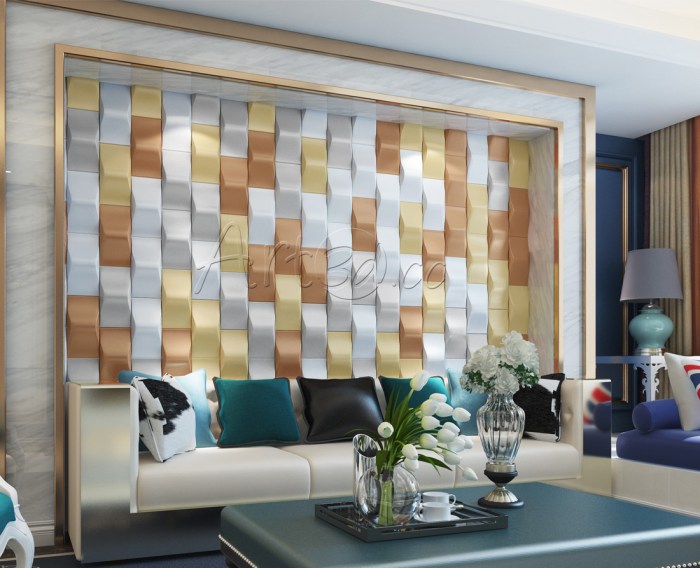
Source: art3d.com
Right, so, let’s get down to brass tacks and talk about choosing the right colours and materials for your living room walls. Getting this right is absolutely crucial, it sets the tone for the whole room, innit? Think of it as the foundation upon which you’ll build your stylish sanctuary.
Die Wirkung verschiedener Farben auf die Raumwirkung
Colour psychology, yeah? It’s a thing. Different colours evoke different feelings. Think calming blues creating a chilled-out vibe, perfect for unwinding after a grueling day at uni. Conversely, vibrant yellows or oranges can inject some serious energy into the space, ideal for a lively social hub.
Reds, while potentially energising, can also be quite intense, so use them sparingly unless you’re aiming for a seriously dramatic effect. Neutrals like greys and beiges offer a blank canvas, allowing other elements in the room to really pop. It’s all about finding the right balance to match your personal style and desired atmosphere.
Die Dekoration der Wohnzimmerwand offenbart viel über den Bewohner – ein Ausdruck von Geschmack, aber auch von Konsumzwang. Oftmals wird die Sehnsucht nach Individualität durch massenproduzierte Dekoartikel ersetzt. Wer jedoch einen wirkungsvollen Akzent setzen will, sollte über ein großes Bild nachdenken, wie man es beispielsweise auf großes bild wohnzimmer findet. Die richtige Wahl eines solchen Bildes kann die gesamte Wandgestaltung und damit den Charakter des Raumes nachhaltig beeinflussen, weshalb die Auswahl der Deko umso wichtiger wird.
Eigenschaften verschiedener Wandmaterialien
So, we’ve got a few key players here: wallpaper, paint, plaster, and wood panelling. Each has its own pros and cons. Wallpaper offers a massive range of patterns and textures, adding instant personality. However, it can be a bit of a faff to put up and even more of a faff to remove. Paint, on the other hand, is super versatile and relatively easy to apply and change.
It’s also generally more affordable. Plaster offers a more textured, rustic look, perfect for a bit of that Scandi vibe, but it can be more challenging to work with and requires a bit more skill. Finally, wood panelling adds a touch of class and warmth, but it can be pricey and may not suit every style.
Drei Farbkonzepte für ein Wohnzimmer
Alright, let’s whip up some colour schemes. First, we’ve got the hell und freundlich concept. Think soft whites, creamy yellows, and pastel blues. Imagine walls painted a soft, warm white, accented with light wood furniture and pops of colour from cushions and throws. It’s all about creating a bright, airy, and inviting space.
Next up, the dunkel und gemütlich look. We’re talking deep blues, rich greens, and warm browns. Picture deep navy walls paired with plush velvet sofas and warm lighting. The aim here is to create a cosy and intimate atmosphere, perfect for snuggling up with a good book. Lastly, the modern und minimalistisch style.
This calls for clean lines and neutral tones. Think shades of grey, white, and perhaps a single accent colour like a muted teal. Minimalist furniture and clean lines are key here. The overall effect is sophisticated and uncluttered.
Dekorative Elemente für die Wohnzimmerwand: Deko Wohnzimmer Wand
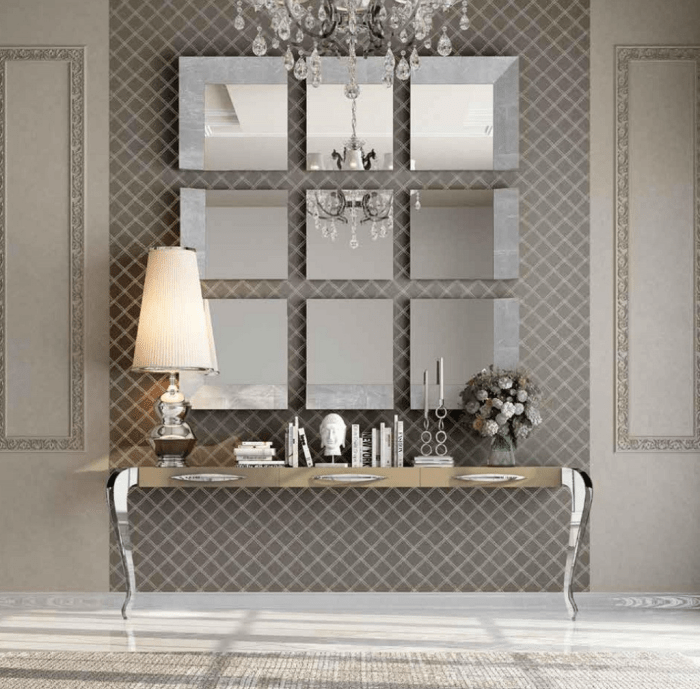
Source: magzhouse.com
Right then, chaps! Let’s get down to brass tacks and liven up those dreary walls, shall we? A bit of wall décor can totally transform a room from a beige-tastic bore-fest to a proper style statement. We’re talking about adding personality, injecting some oomph, and making your living room the envy of all your mates.
Verschiedene Dekorative Elemente und deren Organisation
So, what’s the lowdown on jazzing up your walls? The options are, frankly, rather splendid. We’re looking at a range of decorative elements, each bringing its own unique vibe to the party. Think about size, style, and material – it’s all about creating a cohesive look, innit?
- Bilder: From a single, statement piece to a gallery wall of eclectic prints, pictures offer boundless possibilities. Consider the size – a large canvas can be a focal point, while smaller framed prints create a more curated feel. Materials range from classic oil paintings to modern photographic prints, and the style can be anything from minimalist to maximalist.
- Spiegel: Not just for checking your barnet, mirrors can dramatically alter the perception of space. A large mirror can make a small room feel significantly bigger, while a collection of smaller mirrors can add a touch of vintage glamour. Materials vary wildly, from antique bevelled glass to sleek, modern acrylic.
- Regale: Floating shelves offer a stylish way to display books, plants, and ornaments, adding both visual interest and practical storage. Materials like wood, metal, or even glass can be chosen to complement the overall style of the room. Size and placement are key to avoid cluttering the space.
- Wanduhren: A stylish clock isn’t just functional; it’s a decorative element that can add a touch of personality. From minimalist designs to ornate antiques, the possibilities are endless. Materials range from simple wood to intricate metalwork, and styles run the gamut from modern to traditional.
- Wandteppiche: These bad boys can add texture, colour, and a bohemian vibe to a room. A large tapestry can be a statement piece, while smaller ones can be used to add pops of colour or pattern. Materials range from traditional wool to modern cotton, and styles can be anything from intricate patterns to simple geometric designs.
Drei Wandarrangements
Alright, let’s get creative. Here are three different wall arrangement ideas, demonstrating the versatility of these decorative elements. Remember, this is just a starting point; feel free to mix and match to your heart’s content!
- Arrangement 1: The Minimalist Haven:
- One large, abstract canvas painting in muted tones.
- A single, sleek floating shelf with a few carefully chosen succulents.
- A simple, minimalist clock with a clean, modern design.
This arrangement creates a calm and sophisticated atmosphere, perfect for a relaxing living space.
- Arrangement 2: The Bohemian Rhapsody:
- A large, colourful tapestry with intricate patterns.
- Several smaller framed prints with varied styles and colours.
- A collection of small, mismatched mirrors arranged in a cluster.
- A macrame wall hanging adds extra texture.
This creates a vibrant and eclectic space, full of personality and character.
- Arrangement 3: The Gallery Wall Extravaganza:
- A carefully curated gallery wall featuring a mix of framed prints, photographs, and small pieces of artwork. Varying sizes and frames create visual interest.
- A few small, strategically placed shelves to break up the visual density of the gallery wall.
- A large, ornate mirror placed above the gallery wall to reflect light and add depth.
This creates a dynamic and engaging space, perfect for showing off your personality and artistic flair.
Beleuchtungskonzepte für die Wohnzimmerwand
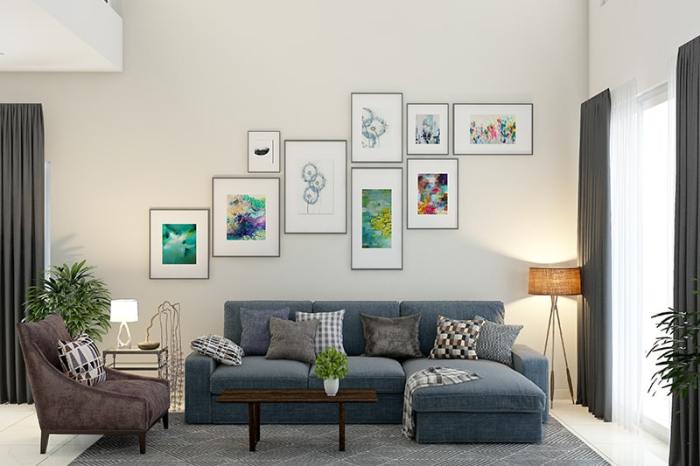
Source: designcafe.com
Licht ist, ganz ehrlich, der absolute Gamechanger in Sachen Raumgestaltung. Es beeinflusst nicht nur die Stimmung, sondern betont auch die texturalen und farblichen Highlights deiner Deko-Wand. Eine gut durchdachte Beleuchtung lässt deine „deko wohnzimmer wand“ richtig strahlen und verwandelt dein Wohnzimmer in einen gemütlichen Chill-out-Bereich oder einen stylishen Hotspot – ganz wie du es dir wünschst.
Die Bedeutung von Licht für die Raumgestaltung und die Hervorhebung von Dekorationselementen
Licht modelliert den Raum und setzt Akzente. Durch gezielte Beleuchtung kannst du Tiefenwirkung erzeugen, bestimmte Bereiche hervorheben und so die Aufmerksamkeit auf deine Wandgestaltung lenken. Warmes Licht schafft eine gemütliche Atmosphäre, während kaltes Licht eher modern und funktional wirkt. Die richtige Lichtwahl ist entscheidend, um die Texturen und Farben deiner Wanddeko optimal zur Geltung zu bringen.
Ein Beispiel: Eine strukturierte Tapete wirkt mit indirektem Licht viel dramatischer als mit grellem Deckenlicht.
Vergleich verschiedener Beleuchtungsmöglichkeiten
Einbaustrahler bieten eine flexible und präzise Ausleuchtung. Du kannst sie gezielt auf Kunstwerke oder andere Deko-Elemente richten. Wandleuchten hingegen schaffen ein gemütlicheres Ambiente und bieten gleichzeitig eine funktionale Beleuchtung. Indirekte Beleuchtung, zum Beispiel durch LED-Streifen hinter Bildern oder Regalen, erzeugt eine weiche, diffuse Ausleuchtung und sorgt für eine besonders stimmungsvolle Atmosphäre. Sie ist perfekt, um die Wand als Ganzes in Szene zu setzen, ohne einzelne Elemente zu stark zu betonen.
Die Wahl hängt letztendlich vom gewünschten Stil und der Art der Wanddeko ab.
Beleuchtungskonzept für ein Wohnzimmer mit „deko wohnzimmer wand“ im Fokus
Hier ist ein Beispiel für ein Beleuchtungskonzept, das die Wandgestaltung in den Mittelpunkt rückt:
- Hauptlichtquelle: Ein zentral platzierter Deckenstrahler sorgt für die Grundbeleuchtung des Raumes. Dieser sollte dimmbar sein, um die Lichtintensität an die jeweilige Situation anzupassen.
- Akzentbeleuchtung: Zwei flexible, schwenkbare Wandleuchten links und rechts neben der Deko-Wand, um einzelne Elemente wie Bilder oder Skulpturen gezielt anzustrahlen. Hier eignen sich Leuchten mit warmweißem Licht für eine gemütliche Atmosphäre.
- Indirekte Beleuchtung: LED-Streifen hinter einem Regal oder einem großen Wandbild, um die Wand indirekt zu beleuchten und eine sanfte, stimmungsvolle Atmosphäre zu schaffen. Die Farbe des Lichts kann hier an die Wandfarbe angepasst werden – ein warmes, bernsteinfarbenes Licht würde beispielsweise bei einer dunklen Wand besonders gut wirken.
- Zusätzliche Beleuchtung: Eine Stehleuchte in der Nähe der Wand kann als zusätzliche Lichtquelle dienen und für ein noch gemütlicheres Ambiente sorgen.
Bilder und Fotografien an der Wohnzimmerwand
Right then, chaps! Let’s get cracking on the visual feast that is your living room wall. Pictures and photographs are a brilliant way to add personality and pizzazz, transforming a blank canvas into a statement piece. The key is finding the right arrangement and style to complement your existing décor.Bilder und Fotografien bieten eine fantastische Möglichkeit, die Persönlichkeit des Wohnzimmers zum Ausdruck zu bringen und gleichzeitig einen optischen Schwerpunkt zu setzen.
Die richtige Anordnung und der passende Stil sind dabei entscheidend, um die gewünschte Atmosphäre zu schaffen.
Galeriewandgestaltung
Creating a gallery wall is a right proper challenge, but the results are totally worth the effort. It’s all about balancing different frame sizes, shapes, and colours to create a cohesive and visually appealing display. Think of it as a curated exhibition of your favourite memories and artistic tastes. A successful gallery wall avoids looking cluttered; instead, it tells a story through the careful selection and arrangement of images.
To achieve this harmonious chaos, start by gathering your chosen pictures and photographs. Experiment with different layouts on the floor before committing to the wall. Consider the size and shape of each frame. Mix and match different frame styles – perhaps some sleek modern frames alongside more ornate vintage ones – for a bit of visual interest. Play with the spacing between the frames, aiming for a balanced but not overly symmetrical arrangement.
A helpful tip is to use painter’s tape to Artikel the frames on the wall before you hammer in those nails. This allows you to tweak the arrangement until you’re absolutely chuffed.
Gestaltung einer Galeriewand mit unterschiedlichen Rahmengrößen und -formen
Let’s get down to the nitty-gritty. When arranging a gallery wall with varying frame sizes and shapes, it’s crucial to maintain visual balance. You can achieve this by employing several techniques. One popular method is to anchor the arrangement with a larger, central piece, then build outwards with smaller frames, creating a sense of visual hierarchy. Alternatively, you could group similar-sized frames together to create distinct clusters within the overall composition.
The key is to avoid a monotonous arrangement; instead, aim for a dynamic and engaging display. Remember, there’s no right or wrong way – it’s all about your personal style.
Konzept für eine Bilderwand, die den Stil des Wohnzimmers unterstreicht
To make your picture wall truly sing, it needs to reflect the overall style of your living room. If you’ve got a minimalist vibe going on, keep the frames simple and the colour palette neutral. For a bohemian feel, embrace eclectic frames and a mix of colours and textures. A classic, traditional living room might benefit from a curated collection of black and white photographs in elegant frames.
Here’s a table illustrating a potential arrangement for a living room with a modern, minimalist style:
| Bild | Größe (cm) | Position |
|---|---|---|
| Abstrakte Landschaftsfotografie | 50 x 70 | Mitte |
| Schwarz-weiß Portrait | 30 x 40 | Links oben |
| Minimalistische Architekturfotografie | 30 x 40 | Rechts oben |
| Kleine, quadratische Landschaftsaufnahme | 20 x 20 | Links unten |
| Kleine, quadratische Architektur Aufnahme | 20 x 20 | Rechts unten |
Praktische Aspekte der Wandgestaltung
Right, so, let’s get down to the nitty-gritty of actuallydoing* something with your Wohnzimmer walls. Before you unleash your inner interior designer, a bit of prep work is crucial – think of it as laying the foundation for a truly smashing design. Proper preparation ensures a flawless finish and prevents those pesky DIY disasters that can leave you feeling more deflated than a punctured bouncy castle.
Wandvorbereitung vor dem Dekorieren
Before even thinking about applying paint, wallpaper, or sticking up your prized family photos, you need to prep the walls like a pro. This involves a three-pronged attack: cleaning, filling, and priming. First, give the walls a thorough clean using warm soapy water and a sponge. This removes dust, grease, and cobwebs – essential for good adhesion. Next, carefully inspect the walls for any imperfections like cracks or holes.
These need filling with a suitable filler, allowing it to dry completely before sanding it smooth. Finally, apply a primer. This creates a uniform surface for your chosen wall covering, ensuring even colour and preventing the old wall from showing through. Think of it as a blank canvas for your masterpiece.
Methoden zur Befestigung von Dekorationselementen, Deko wohnzimmer wand
Alright, so you’ve got your stunning wall décor ready to go. Now, how do you actually get it onto the wall without causing a ruckus? Several methods exist, each with its own pros and cons. Nails are a simple, straightforward option for lighter items, but be mindful of the wall material – plasterboard needs appropriate plugs to prevent damage.
For heavier items, wall plugs and screws offer superior strength and stability. They’re essential for shelves or large picture frames. Finally, adhesive strips or tapes provide a damage-free option for smaller, lighter decorations, perfect for temporary displays or those renting their abode. Remember to always check the weight limits of the adhesive before using it.
Schritt-für-Schritt-Anleitung zum Anbringen einer Tapete
Right, let’s tackle wallpapering. This might sound daunting, but with a bit of patience and the right tools, you’ll be a wallpapering whiz in no time. First, measure and cut your wallpaper strips, adding a few extra centimetres for trimming. Apply the paste evenly to the back of the wallpaper, following the manufacturer’s instructions. Then, carefully align the first strip with a plumb line and smooth it onto the wall, working from the centre outwards to avoid air bubbles.
Overlap subsequent strips slightly and use a smoothing tool to remove any creases. Finally, trim the excess wallpaper at the top and bottom using a sharp knife or cutter. Remember, a steady hand and a bit of patience are key here. It’s all about precision and finesse.
Welche Wandfarbe eignet sich für ein kleines Wohnzimmer?
Helle Farben wie Weiß, Beige oder Hellgrau lassen kleine Räume größer wirken. Vermeiden Sie dunkle Farben, die den Raum optisch verkleinern können.
Wie kann ich eine Galeriewand richtig planen?
Beginnen Sie mit einem zentralen Bild und fügen Sie weitere Bilder in verschiedenen Größen und Formen hinzu. Achten Sie auf einen ausgewogenen Aufbau und lassen Sie etwas Raum zwischen den Bildern.
Welche Dübel eignen sich für schwere Bilder?
Für schwere Bilder benötigen Sie robuste Dübel, die der Belastung standhalten. Die passenden Dübel hängen vom Wandmaterial ab (z.B. Gipskarton, Beton).
Wie entferne ich alte Tapetenreste?
Alte Tapetenreste können mit einem Dampftapetenlöser oder einem Spachtel entfernt werden. Vorsicht, dies kann sehr zeitaufwendig sein.

